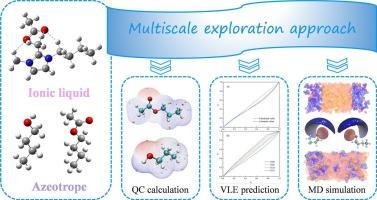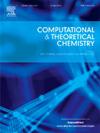Multiscale exploration of ionic liquids for the separation of n-butanol/n-butyl acetate azeotrope
IF 3
3区 化学
Q3 CHEMISTRY, PHYSICAL
引用次数: 0
Abstract
The development of green and efficient entrainers is critical for the extractive distillation process of alcohol-ester azeotropes. This study proposes a feasible method for separating the n-butanol (NBA) and n-butyl acetate (NBAC) azeotrope using acetate-based ionic liquids (ILs) as entrainers. Thermodynamic properties, including solvent capacity and selectivity, were first computed using the conductor-like screening model for real solvents (COSMO-RS) to identify three potential IL entrainers. A systematic quantum chemistry approach was then employed to explore the structure–activity relationships between azeotropic components and ILs. The results indicated that van der Waals and hydrogen bond (H-bond) interactions are the primary driving forces for separating the azeotropic mixture, with H-bond making a major contribution. Furthermore, phase equilibrium predictions revealed that the addition of ILs significantly impacts the phase behavior of the mixture systems. Among the tested ILs, tetrabutylammonium acetate ([N4444][Ac]) demonstrated the best separation performance. Finally, molecular dynamics simulations were conducted to explore intermolecular interactions in the actual solvent environment and further confirmed the presence of H-bonds between the [Ac]− and NBA. This study provides valuable insights into the development of entrainers and the industrial application of alcohol-ester azeotrope separation.

离子液体分离正丁醇/乙酸正丁酯共沸物的多尺度探索
开发绿色高效的夹带剂是醇酯共沸物萃取精馏的关键。本研究提出了一种以醋酸盐离子液体为夹带剂分离正丁醇(NBA)和乙酸正丁酯(NBAC)共沸物的可行方法。热力学性质,包括溶剂容量和选择性,首先使用真实溶剂类导体筛选模型(cosmos - rs)计算,以确定三种潜在的IL夹带剂。然后采用系统的量子化学方法探讨了共沸组分与il之间的构效关系。结果表明,范德华相互作用和氢键相互作用是分离共沸混合物的主要驱动力,其中氢键起主要作用。此外,相平衡预测表明,加入ILs对混合体系的相行为有显著影响。其中,四丁基乙酸铵([N4444][Ac])的分离效果最好。最后,通过分子动力学模拟探索了实际溶剂环境下的分子间相互作用,进一步证实了[Ac]−和NBA之间存在氢键。本研究为夹带剂的发展和醇酯共沸分离的工业应用提供了有价值的见解。
本文章由计算机程序翻译,如有差异,请以英文原文为准。
求助全文
约1分钟内获得全文
求助全文
来源期刊

Computational and Theoretical Chemistry
CHEMISTRY, PHYSICAL-
CiteScore
4.20
自引率
10.70%
发文量
331
审稿时长
31 days
期刊介绍:
Computational and Theoretical Chemistry publishes high quality, original reports of significance in computational and theoretical chemistry including those that deal with problems of structure, properties, energetics, weak interactions, reaction mechanisms, catalysis, and reaction rates involving atoms, molecules, clusters, surfaces, and bulk matter.
 求助内容:
求助内容: 应助结果提醒方式:
应助结果提醒方式:


